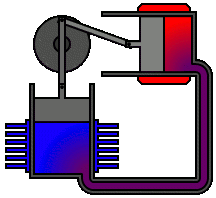Dave, even though it might seem similar, it is really not.
The stirling engine works by the carnot cycle.
The carnot cycle got 4 stages:
Adiabatic compression - pressure is rising without a significant volume change, due to the heating of the gas.
isothermal expansion - the volume increases, but since the gas is still being heated, the pressure does not decrease significantly.
adiabatic expansion - The pressure decreases without a significant volume change due to cooling of the gas
Isothermal compression - The volume decreases without a significant increase in pressure as the gas is still cooled.


The sum of the integral in the pV-diagram is positive - work done.
This works because there is a 90° phase shift between the two pistons. (does not have to be exactly 90°, but close)
But the pV-diagram for your double cooled engine would form a line, not the "paralellogram" in the above diagram, the sum of the integral is zero - no work done. Although there is still friction losses.
I pretty much understood this today myself :)



